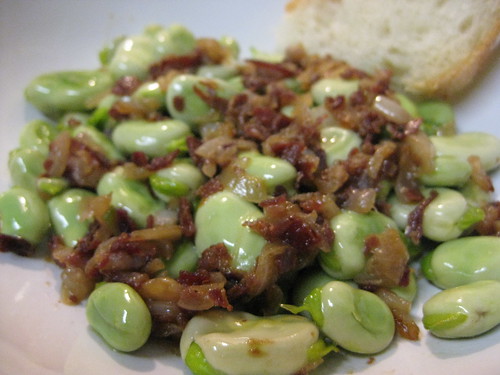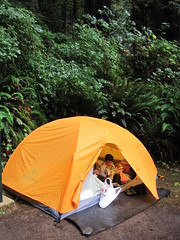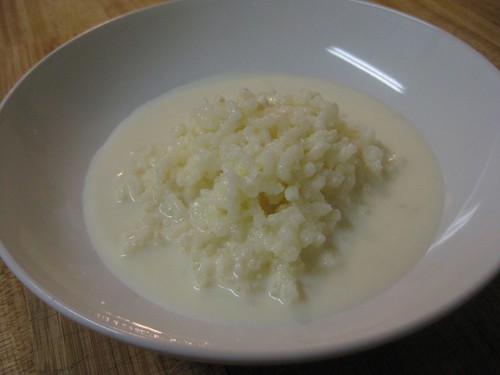I’ve been thinking about writing about cooking in this blog for a while. Not just to share what I’ve learned, because, well, I don’t have much to share, but to get other people’s ideas and suggestions. While I may cook better than the average American and may be able to impress my wife and friends, I’m not really such a good cook. I know how to follow recipes, and I’m starting to get some sense of what works and what does not, but I have a lot to learn, which is actually fascinating; there’s a whole world of flavors out there and exploring it is a very rewarding experience.
It took me a while to get used to cook in the US. Spanish cooking is not very sophisticated, but it’s based on seasonal dishes and the use of high quality ingredients available locally. Not the kind of thing you find in the US at your nearest supermarket.
This is all changing very quickly, but many of the traditions still remain. I for one grew up without paying to much attention to food. I just thought it was fuel for my body. It was only when I moved to the US that I started to appreciate what I used to have and now missed.
The Mediterranean diet is mostly composed of olive oil, bread, fresh fruits, fish and vegetables. However, I grew up in a family that runs a pork farm and a small meat production and distribution business. So, I had a larger share of meat than the average. Despite of that, meat was most often used as a condiment or in small dishes, except on special occasions.
[missing image – Iberian pigs in the Dehesa]
Our pork is unlike any other. Most of it is free-range and acorn-fed, which gives its meat a very distinct flavor. It is generally destined to the production of the finest quality deli meats: cured ham, loins, and sausages.
As far as I know it’s not possible to find anything like that in the US. Exports of Iberian ham are legal now, but the FDA requires installations to be periodically inspected and approved. Small farmers cannot really afford to comply with all the requirements of the FDA, so the only ham that you can usually find in the US is from larger and lower quality producers.
To add more insult to injury, the low quality ham that is available here is sold at outrageous prices, as if it were a high quality product! If you are not discouraged yet, you can find some of it at the Spanish Table, or at online retailers such as La Tienda.
I would not recommend any of those options. Instead, what I do is to bring some of our ham with us every time we travel to Spain. This is actually illegal, but is usually safe. However, once we tried to bring an entire leg and, much to our dismay, it was confiscated by the border officers. Since then, I only bring small quantities that are hardly noticeable on the scanner.
Rather than eating all of it right away, I generally save it for months, waiting for the right opportunity to enjoy it. Last weekend that opportunity presented itself in the form of fresh fava beans:

Fava beans are delicious eaten raw, or simply sautéed in olive oil with red onions. However, a little bit of Iberian Ham turns that delicious dish into a delicacy.
The preparation is trivial:
- Remove the beans from their pods. It’s possible to also remove the beans from the shells by cooking them in boiling water for a short period of time and cooling them quickly in cold water. I personally don’t bother with that and leave the beans in their shells.
- Pour a small amount of olive oil on a sauté pan on high heat. Chop the onions and the ham, and cook until flagrant.
- Then add the beans, season to taste with salt and freshly ground pepper, and cook lightly for a few minutes while stirring often.

Let me know if you like posts like this, and if so, in future posts I’ll continue rambling about my quest to adapt the traditional Spanish recipes to the resources available in the US.
6 Comments
Chewie
Posted 18/5/2009 at 4:04 am | Permalink
Habas con jamón…. Yummy!
Did I tell you I bought a bread machine? I plan to make sourdough bread as soon as I’m able to grow the culture.
cb
Posted 18/5/2009 at 8:07 am | Permalink
Yeah, fantastic post, more!
Jesus
Posted 18/5/2009 at 2:54 pm | Permalink
¡Habas con jamón! ¡Rico, rico!
Well done! I have the same problem finding cured ham in England, and I also follow the same procedure to bring some here, although I haven’t tried yet to bring a whole leg :D
Chad Austin
Posted 18/5/2009 at 4:46 pm | Permalink
I love all food, so more!
castano
Posted 18/5/2009 at 7:02 pm | Permalink
Thanks for all the feedback! I think that next I’ll share my technique to make a basic pâté.
Nick
Posted 19/5/2009 at 8:47 pm | Permalink
Great post, thanks! BTW, I like your typo “cook until flagrant”, it makes the meal seem much more exotic :) If you ever find a source for good quality hams please post it!




